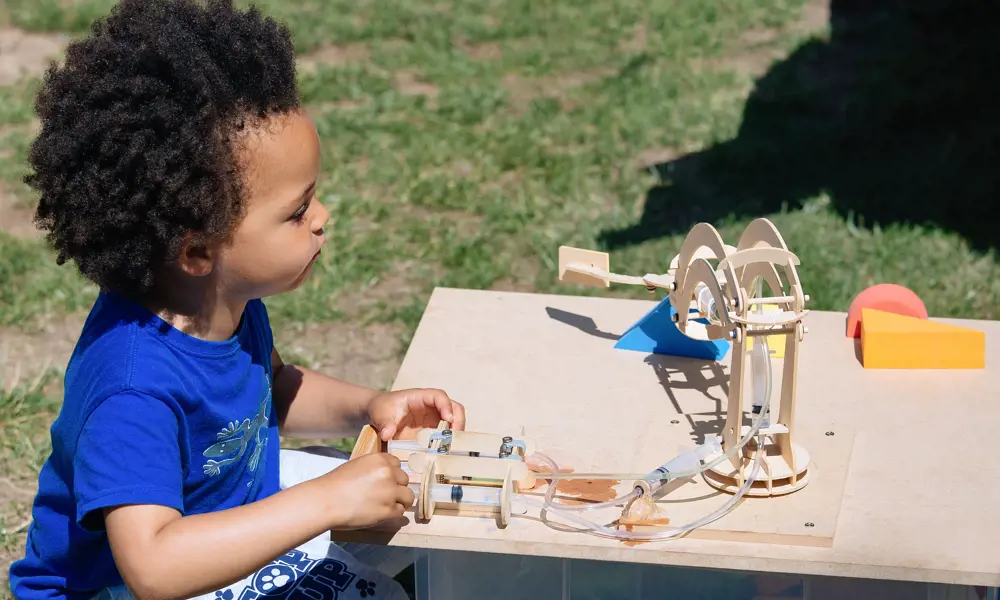
An ingenious introduction to engineering

Ingenious funds projects that aim to engage the public in engineering and encourage more engineers to share their experiences with wider audiences © SMASHfestUK
With 2018 as the Year of Engineering, a government-led national campaign to inspire the next generation of engineers and widen the pool of young people who join the profession, it is now more important than ever to engage people with engineering. At the core of the Royal Academy of Engineering’s Ingenious scheme is the aim to inspire creative public engagement with engineering projects, and motivate engineers to share their stories and expertise with wider audiences.
In a bid to increase participation by people from all backgrounds, the scheme prioritises projects that reach diverse and underrepresented audiences, including communities in the most deprived neighbourhoods in the UK. Research from a CaSE report suggests that young people from black, Asian and minority ethnic (BAME) backgrounds and children growing up in poverty are far less likely to enter STEM industries as a career. The ASPIRES Report: Young people’s science and career aspirations age 10–14, published by Kings College London in 2013, found that girls, especially black students, are less likely than boys to aspire to STEM-related careers.
The projects that Ingenious funds creatively demonstrate engineering in all its forms, from a young inventors’ club in a museum and a radio programme about railway infrastructure, to a touring STEM festival and a musical show that blends engineering with theatre.
Britain's digital railways
Britain’s digital railways is a series of short radio programmes for children that explains how new construction and digital technologies are creating extra capacity on Britain’s railways. Put together by Children’s Radio UK, a 24/7 children’s radio station, the short programmes explore different aspects of both historical and current railway infrastructure and discuss future engineering.
Creating inspiring content to introduce new ideas to children is nothing new to Children’s Radio UK. Its earlier series have covered everything from art and chemistry to the ExoMars Rover and dinosaurs. The content is short: just three minutes to ensure that it can keep children engaged and effectively communicate a tiny part of a subject.
Its earlier series have covered everything from art and chemistry to the ExoMars Rover and dinosaurs. The content is short: just three minutes to ensure that it can keep children engaged and effectively communicate a tiny part of a subject
A conversation that Children’s Radio UK had with Hitachi about its new high-tech trains inspired the project. The team realised that the trains were just a small part of the engineering involved, and that the task of building the tracks and infrastructure is just as important. It decided to create a series that looks at the infrastructure of railways rather than the trains themselves, exploring the impact of developing railways on people’s lives and communities.
Including young engineers was a key part of creating the radio programmes. Children’s Radio collaborated with Transport for London (TfL) and Network Rail to ensure that the engineering included in the programmes was up to date, and selected 10 ambassadors to help create the shows. Before recording the shows, the team spoke to primary school children about their ideas for the future of the railway. Their suggestions included everything from a carriage that was a cinema to a nuclear-powered train that would travel at super speed, and their ideas helped the team decide what type of content would interest them.
The series includes topics such as how to run more trains more often, tunnelling under major cities and building embankments in the countryside, rebuilding operational stations, electrification and alternative energy, and communications between trains. The series includes 22 three-minute radio programmes, each accompanied by an animated video.
The series includes 22 three-minute radio programmes, each accompanied by an animated video.
Children’s Radio UK also worked with the ambassadors to create media training workshops for over 100 young engineers and apprentices. The day-long workshops helped the participants learn how to research and prepare a talk, and develop their interview skills, as well as including practical time to record audio about their jobs and engineering experiences. The workshops have helped engineers to reach children, teaching them how to communicate their jobs to a young audience, and discover that their jobs fascinate and engage children. The team is releasing the interviews that the engineers recorded in these sessions as podcasts, aimed at a slightly older audience.
Children’s Radio UK is now working on further engineering-related series: a ‘how is that made?’ series will look at production of everyday objects from the toothbrush to the carpet; a series exploring the opportunities to develop spaceports in the UK; and a new series focused on the 2018 Year of Engineering.
To download the podcasts, visit www.funkidslive.com/railway
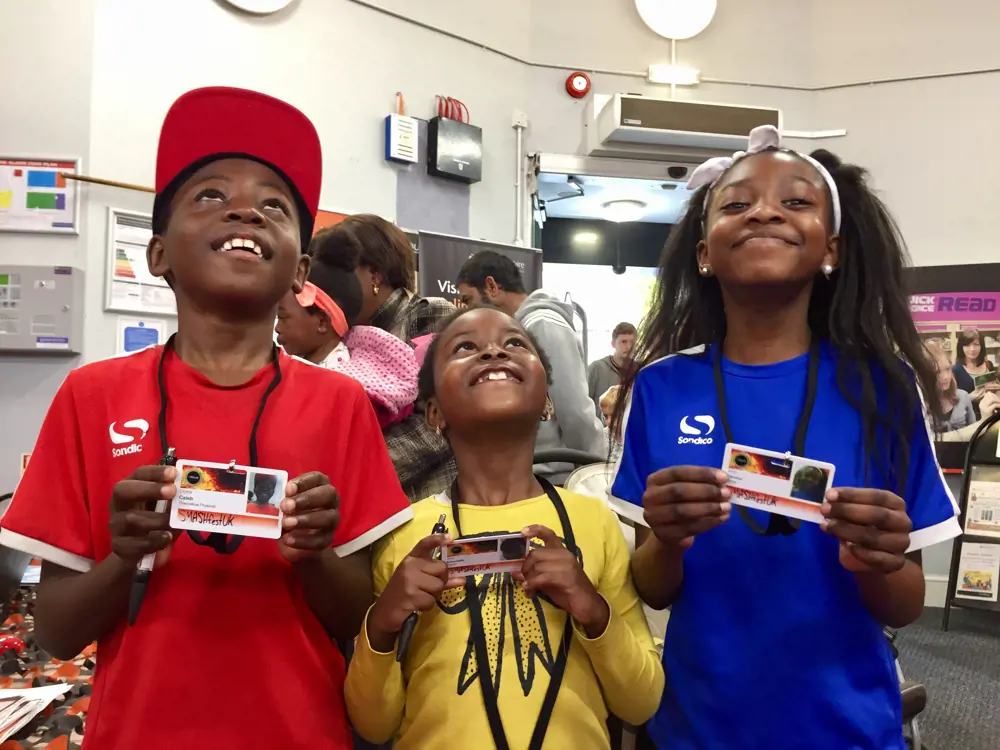
Participants at the Gloucester event with their new work ID cards © SMASHfestUK
SMASHfestUK: The Earth and Sky tour
The concept for SMASHfestUK grew out of Wyn Griffiths’ idea of creating a mini festival for his wife Lindsay’s birthday. Following the success of the event, the couple – working with Middlesex University and Lindsay’s company The Refinery – wanted to organise a festival that could engage communities with science, technology, engineering, maths and the arts (STEAM).
After the publication of King’s College London’s ASPIRES report and the Warwick Commission’s Enriching Britain: Culture, creativity and growth report, which both showed the lack of underserved and underrepresented groups progressing in STEAM subjects, the team decided to take its festival on a tour of disadvantaged areas in the UK. The aim was to break down barriers to social inclusion and STEAM engagement and focus on communities with multiple indicators for poverty.
SMASHfestUK works with local community groups, universities, schools, cultural organisations and young people to design festivals that are narrative-driven and entertainment-led, but include lots of STEAM activities. The team designs the festivals to appeal to parents just as much as younger audiences, creating intergenerational learning experiences.
In 2017, the festival imagined a world that has just been destroyed by a supervolcano, which allowed groups from all areas and backgrounds to engage in the topic. Participants helped to rebuild the world after the natural disaster, with a series of activities that used engineering to solve problems. The challenges included using scrap material to assemble structures, creating filters to provide safe drinking water, building piping and heating systems, and making rocket stoves from bricks. A core of engineers and scientists from universities and industry support the activities, as well as volunteers from the community. The Women’s Engineering Society often sends volunteers, and SMASHfestUK ensures that its engineers represent a diverse range of ethnicities, genders and socioeconomic backgrounds, so that children and parents can meet engineers who they can identify with. A parent who attended said that it was “wonderful to see engineering really brought to life, with women engineers. Our daughter, and the girls in her class, will be inspired by this”.
It was wonderful to see engineering really brought to life, with women engineers. Our daughter, and the girls in her class, will be inspired by this
To discover the impact of the festival, the team measures both quantitative postcode and demographic data on attendance, as well as qualitative data about experience. An activity that resonates with many of the participants is making ID cards: visitors talk to the team about their aspirations and the job that they think would best suit them in a disaster situation, before creating their own professional card that includes their name, future job and photo. The activity is a way of integrating the earlier hands-on activities and embeds their aspirations into a meaningful artefact that they can take home.
The data has revealed that 62% of attendees were interested in STEM careers after attending the festival, with a further 18% interested in arts careers. Interestingly, in Gloucester a large proportion of attendees were interested in medical careers, while in Greenwich, visitors were most interested in engineering.
In 2018, its fourth year, the survival village will be dealing with the after-effects of a flood, the first scenario that may have affected attendees in the UK. SMASHfestUK hopes to get more engineering companies involved in supporting the project, to make it more sustainable in the long term.
For more information about SMASHfestUK and to find out where the festival will be next, visit www.smashfestuk.com
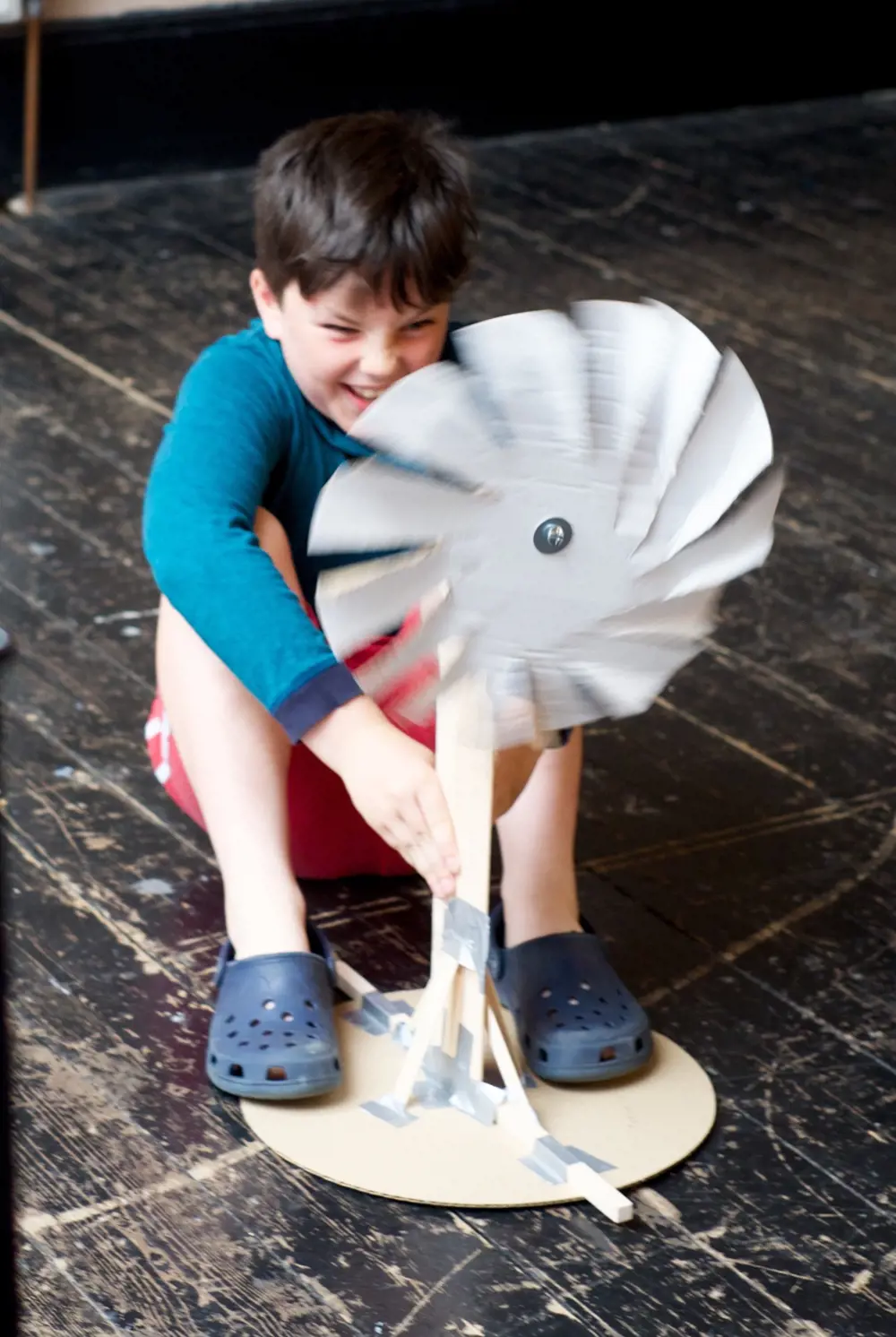
An attendee builds and operates his own wind turbine © Discovery Planet
Turbines: A wind-wind solution
A two-day event created by grassroots organisation Discovery Planet helped local people learn about the giant offshore wind farm near their homes. The organisation worked with the University of Kent and renewable energy companies Vattenfall and London Array to teach the community about one of the world’s largest wind farms, located just off the Thanet coast in Kent.
The project took over a working café in Cliftonville, Margate, the fifth most deprived ward in England and home to a particularly diverse community. On the first day, Discovery Planet invited six local schools and home-educated children to learn about wind turbines through three different activities. On the second day, the café was open to everyone for free drop-in sessions. The University of Kent’s School of Physics held six workshops about electricity and generation on each of the two days, and a retired engineer discussed renewable energy and designing wind farms. Participants had an opportunity to design and make their own wind turbine from a range of materials, including wood, paper, straws and beads. Volunteer engineers from various disciplines helped the children to work on and refine their designs, and they could test the turbines with a large fan. On another floor, there was a virtual reality experience that allowed participants to simulate climbing the stairs inside a
wind turbine.
Volunteers from STEM Learning’s ambassador programme and postgraduate engineers were available to answer questions about engineering, and the event coincided with International Women in Engineering Day. One participating volunteer said: “There were a good number of female engineers and scientists, such as myself, going around and speaking to the young girls and dispelling the myth that engineers and scientists are male. A number of girls said that they wanted to be scientists.”
There were a good number of female engineers and scientists, such as myself, going around and speaking to the young girls and dispelling the myth that engineers and scientists are male. A number of girls said that they wanted to be scientists
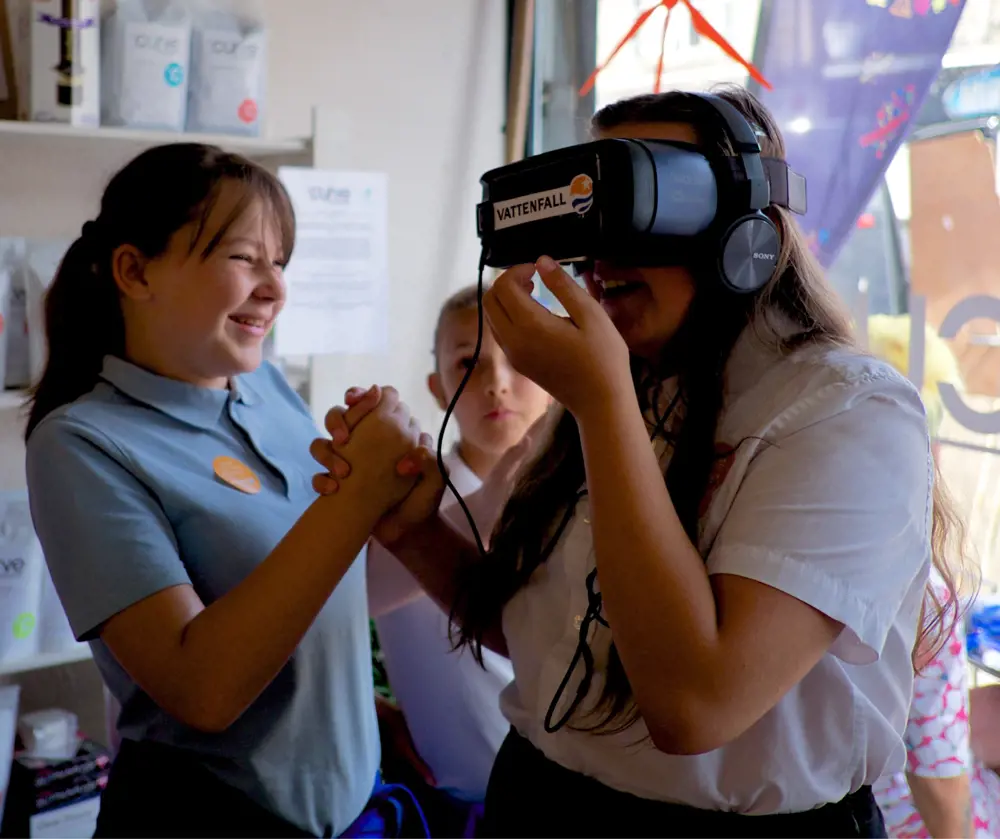
School students try out the virtual reality experience © Discovery Planet
Discovery Planet tries to ensure that all its activities are free and accessible, and often uses empty shops or market stalls so that people stumble across the events. The events create a great opportunity for engineers to get involved in community outreach and the pop-up format is an effective way of reaching underserved audiences and presenting STEM activities in an unusual way. Discovery Planet has enabled other organisations, such as the University of Kent and Vattenfall, to conduct more outreach with disadvantaged communities. The local windfarm offers a good opportunity to connect the idea of engineering as a career with a firm example.
The organisation used feedback forms with both open and closed questions to monitor the impact of the event. Highlights included a changed attitude to engineering, stereotypes of engineering, and a better idea of how engineering affects people’s lives. The feedback forms asked participants to describe engineering in three words after taking part in the event. Many of the responses contradicted stereotypes and included: “designing, creative, innovative”; “cutting edge, exciting, fun”; “amazing, special, curious”. Working with engineers helped to change people’s perception of engineering and what engineers do, with one commenting “I gained a better understanding of how engineering improves our lives”.
The organisation’s next event at pop-up stalls in Ramsgate Market will be all about genes. For more information, visit the Facebook page at www.facebook.com/DiscoveryPlanetRamsgate
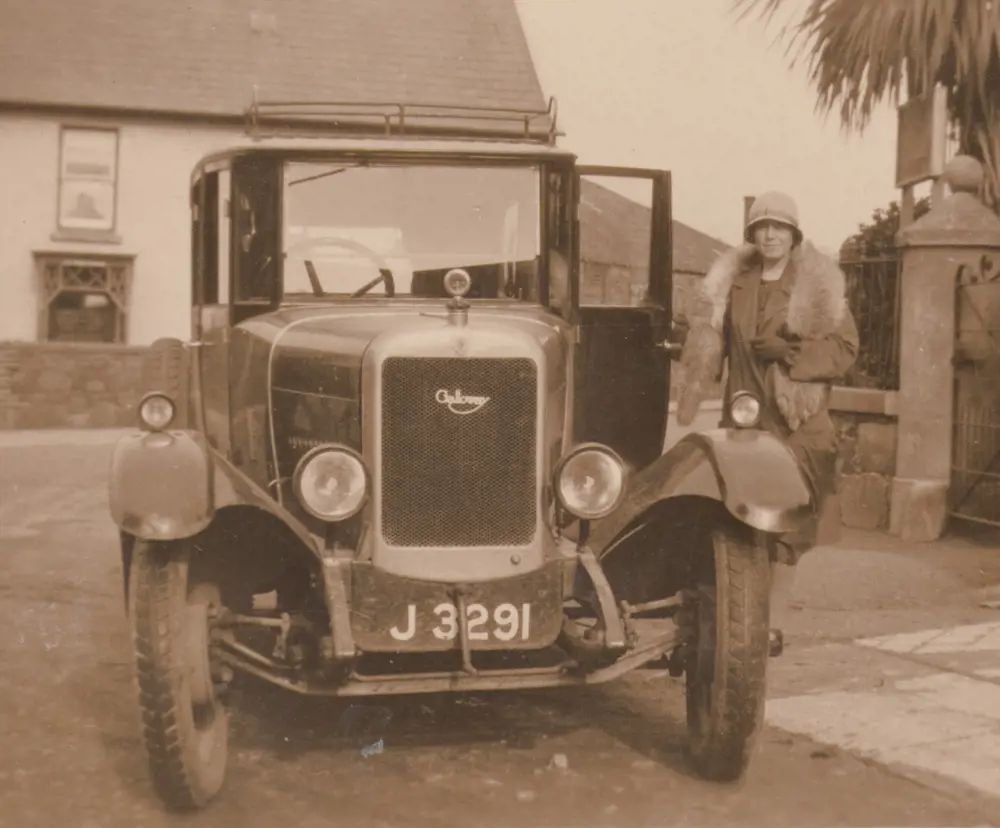
Dorothée Pullinger with one of her Galloway cars © Le Couvey-Martin Family Archives
A car for women and other stories
At the University of the West of Scotland (UWS), an interdisciplinary team of engineers, cultural theorists, filmmakers and media specialists are creating a film about engineering pioneer and local hero, Dorothée Pullinger.
Engineers Professor Katherine Kirk and Dr Evi Viza are working with filmmaker Tony Grace, cultural theorist Professor Katarzyna Kosmala, Dr Nina Baker, an independent women’s engineering historian, and Neil Johnson-Symington, Curator at Riverside Museum of Transport in Glasgow, on the project about Dorothée’s life and work. With Dorothée’s local roots and history of championing women’s involvement in engineering, she was an obvious fit for a film exploring women’s engagement with engineering.
Dorothée’s engineering career began at the age of 16, when she started working in a Scottish car factory. During the First World War, she managed 7,000 women munitions workers, before becoming director of Galloway Motors, which had an innovative apprenticeship programme for women. Here, she was integral to the production of the Galloway car – a smaller, lighter car for women that was not only designed for women but was built almost entirely by women. When the traditional engineering societies continued to reject applications from women, Dorothée became one of the founding members of the Women’s Engineering Society, which is still inspiring and supporting girls and women to achieve their potential as engineers today.

Women working at Arrol Johnston’s Heathhall works © Le Couvey-Martin Family Archives
The film is part of a three-year project that aims to inspire the next generation of women to pursue careers in engineering by revealing the untold histories of women engineers. The film will be a vehicle for the project to tell Dorothée’s story, and will have an impact across different areas; as well as reaching engineers through exemplars of engineering, it is also providing creative opportunities for cultural and media students. The film has inspired UWS music MA students, who have produced songs written from the point of view of the women engineers who moved to Dumfries to work on the car.
This is the team’s first STEM public engagement project and aims to promote a better understanding of engineering careers, including contributions from present-day engineers. It chose Dorothée as a character who would create strong public interest, but also enabled engagement with Scotland’s industrial heritage. The team hopes that the film will help to change professional and organisational cultures as well as academic cultures and teaching. The aim is that the project will inspire further research into the area, uncovering more untold stories of women and putting them into the public domain. The project is included in the UWS prospectus, so is already encouraging the next intake of students to consider a career
in engineering.
While various events have piloted sections, the full film is still in production. The project is being launched in June to celebrate International Women in Engineering Day, and public events across the UK will show the film to celebrate the Year of Engineering. It will be shown at the UWS campuses, Queen Elizabeth University Hospital in Glasgow and will be available to stream.
Keep calm! I'm an engineer
STEM organisation ‘science made simple’ develops shows for schools, events and festivals. Its latest engineering workshop explores how people could use basic engineering to re-establish a post-apocalyptic world.
The science made simple team found that people who are deaf or hard of hearing are often an underserved audience, so wanted to create a fun, interactive workshop for audiences with hearing impairments. The workshop is based on Lewis Dartnell’s book The Knowledge, in which the world as we know it has ended and survivors must start to rebuild civilisation. The book is a thought experiment that explores how to grow food, generate power, prepare medicines, and extract metal from rocks in a world with no modern conveniences.
The science made simple team found that people who are deaf or hard of hearing are often an underserved audience, so wanted to create a fun, interactive workshop for audiences with hearing impairments
The organisation wanted the workshop to reflect the book, but go beyond immediate post-apocalypse survival and focus on how engineering could rebuild society. It chose three key features that are essential for a functioning society – communication, power and transport – and worked with engineers to create activities that allow participants to use basic engineering principles to solve these problems.
The workshop will focus on a scenario where the participants are trying to send a resource across the English Channel to other survivors in Europe. They will need to communicate their plan to those receiving the resource, design a mechanism to help them lift heavy materials, and build a boat to carry the resources across the English Channel.
A short animation without sound will introduce the workshop, and British Sign Language interpreters will help with activities to aid communication. The workshop uses problem-solving to give participants the chance to be creative and address the challenges in their own way rather than through a list of instructions. While science made simple usually puts on shows for larger groups, these workshops are much smaller, which allows the organisers to engage more closely with individuals and create more hands-on learning opportunities. As many schools are looking for increasing ways to integrate engineering and engineering-based activities into the curriculum, the workshops will visit six secondary schools, as well as festivals, where they will reach family audiences.
Science made simple has reached over 750,000 people in the 15 years that it has been running shows, and aims to inspire the next generation of scientists and engineers while engaging the wider public with STEM. The team constantly evaluates its shows to discover what sections and activities audiences enjoy most and least, and what they learned from the interaction. In its school shows, over 91% of pupils said that they had learned something and over 66% were more interested in science afterwards.
The Keep Calm! I’m an Engineer workshops will be taking place later in the year.
For more information about science made simple, visit www.sciencemadesimple.co.uk
***
This article has been adapted from "An ingenious introduction to engineering", which originally appeared in the print edition of Ingenia 74 (March 2018).
Contributors
Portia Sale
Author
Keep up-to-date with Ingenia for free
SubscribeOther content from Ingenia
Quick read

- Environment & sustainability
- Opinion
A young engineer’s perspective on the good, the bad and the ugly of COP27

- Environment & sustainability
- Issue 95
How do we pay for net zero technologies?
Quick read

- Transport
- Mechanical
- How I got here
Electrifying trains and STEMAZING outreach

- Civil & structural
- Environment & sustainability
- Issue 95